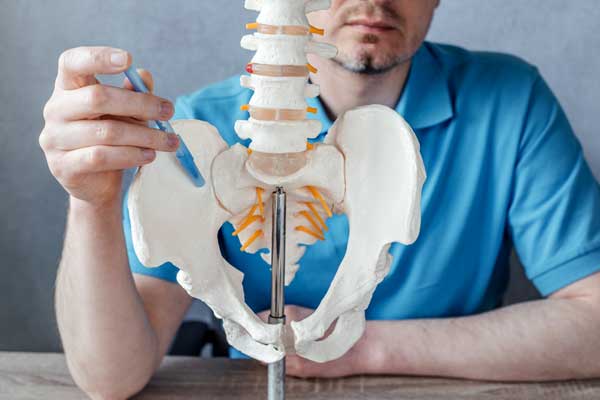Fibromyalgia can be a debilitating condition that causes widespread pain and fatigue, as well as other symptoms like headaches, cognitive issues, and depression. But for many people with fibromyalgia, one of the most uncomfortable side effects is buttocks pain.
If you suffer from this type of chronic pain due to your fibromyalgia diagnosis, treatments are available to help manage your discomfort.
In this article, we’ll explore what causes fibromyalgia-related buttocks pain, how it’sit’s diagnosed and treated medically and naturally, and coping strategies to help you better manage your daily symptoms.
By understanding more about why you experience these types of pains associated with fibromyalgia—and how to treat them—you will be able to find relief and live life with greater ease despite your diagnosis.
Fibromyalgia and Buttocks Pain: What You Need to Know
If you have fibromyalgia, you know that the condition can cause various symptoms, including pain in the buttocks.
It’s essential to be aware of the symptoms of fibromyalgia and buttocks pain so that you can seek medical help if needed.
Symptoms of Fibromyalgia and Buttocks Pain
The most common symptom associated with fibromyalgia is widespread musculoskeletal pain or tenderness. This kind of pain affects both sides of your body equally and may also include stiffness in the morning or after periods of inactivity.
Your level of discomfort may even worsen after physical activity or under stress. In addition, tender points—specific areas on your body where pressure causes pain—are often present in people with fibromyalgia, especially around the neck, shoulders, back, hips, arms, and legs.
Buttocks pain is a common symptom for those suffering from fibromyalgia as well. You may experience a burning sensation or itch in one or both cheeks that radiate into your legs.
The area may also feel sore or sensitive to touch and can sometimes become very painful—especially when sitting for extended periods. Some people also report difficulty sleeping due to this type of pain caused by fibromyalgia.

What Causes Fibromyalgia and Buttocks Pain
FMS can affect various body parts, including the buttocks, hips, and lower back. Other potential triggers include traumatic events such as physical or emotional abuse or injury; infections; hormonal changes; certain medications; stress; and environmental factors such as air pollution or cigarette smoke.
Myofascial pain syndrome
Myofascial pain syndrome (MPS) is another potential cause of fibromyalgia and buttocks pain. MPS is a chronic disorder characterized by painful knots in the muscles called trigger points throughout the body.
These knots can cause mild to severe pain when they become irritated or inflamed due to overuse or injury. MPS can also be caused by poor posture or bad ergonomics while sitting at a desk all day.
Infections
Certain types of infections can also cause fibromyalgia and buttocks pain. For example, Lyme disease is an infection caused by bacteria found in ticks that can lead to joint inflammation, leading to chronic pain in vulnerable areas such as the buttocks and hips.
Bruising
One possible cause of buttock pain is bruising. This can happen if you fall or experience a significant impact on or near your buttocks area. Bruising will usually present as an area that is painful and tender to the touch.
Depending on the severity of the bruise, it may also be accompanied by discoloration or swelling. If your buttock pain seems to have come on suddenly after a fall or other impact, this could likely be the culprit.
Muscle Strain
Another possible cause of buttock pain is muscle strain. This can occur if you do too much physical activity without stretching beforehand or need to warm up properly before exercising.
Muscle strain can make it challenging to move around and make sitting down uncomfortable due to its location near your buttocks.
The effective way to treat muscle strain is with rest and ice, so be sure to take it easy for a while and apply cold packs over the affected area periodically throughout the day.

Sciatica
One more possible cause of buttock pain could be sciatica. Sciatica is characterized by radiating nerve pain from your lower back down through your legs and feet; however, it can also cause discomfort in the buttocks.
If this sounds like something has been bugging you for a while now, see a doctor immediately so they can diagnose and treat it accordingly!
Bursitis
Bursitis means inflammation of the bursa sacs located around your joints. It can cause pain in your buttocks and other body parts, such as your shoulders and hips.
The most common cause of bursitis is excessive use or repetitive motion activities. Other causes include direct trauma to the area, infection, and rheumatoid arthritis.
Treatment for bursitis typically includes rest, ice or heat therapy, stretching exercises, NSAIDs, and sometimes corticosteroid injections.
Herniated disk
A herniated disk is another possible cause of buttock pain. This condition occurs when one of the disks between the vertebrae in your spine ruptures or bulges out and presses against a nerve root near the spine.
Symptoms include lower back pain and buttock pain that radiates down one leg or both legs, depending on which nerve root is affected by the herniated disc.
Treatment may include physical therapy, medications (such as muscle relaxants and NSAIDs), epidural steroid injections, or surgery if necessary.
Degenerative Disk Disease
Degenerative disk disease (DDD) is a condition that develops over time due to wear and tear on the intervertebral discs in your spine.
As these discs deteriorate over time, they can become less flexible and less able to absorb shock from movement resulting in chronic pain in your lower back and buttocks when pressure is applied to them from activities like walking or running.
Treatment options for DDD include physical therapy, medications (such as muscle relaxants), epidural steroid injections, or surgery if necessary.
Perirectal Abscesses
A perirectal abscess is an infection of the tissue around your rectum that becomes filled with pus and other fluids from an illness.
It typically begins as a painful lump that grows larger over time until it bursts open and drains out its contents; this drainage often causes extreme discomfort when seated due to pressure on sensitive areas around your rectum.
These abscesses generally require surgical drainage because antibiotics alone will not altogether remove them. Without treatment, they can spread to other organs in your body, causing further health complications.

Sacroiliac Joint Dysfunction
Sacroiliac joint dysfunction (SIJ) is a condition that affects the joints located at the bottom of your spine, where the sacrum and ilium meet.
It often causes pain and stiffness in the lower back that can radiate down into the buttocks and legs. Other symptoms include:
- Difficulty standing up after sitting for extended periods.
- Changing positions while lying down.
- Feeling weak or unsteady when walking.
Piriformis Syndrome
Piriformis is a small muscle located deep in the buttocks. The sciatic nerve runs through the center of this muscle, so when inflammation or tightness occurs in the piriformis, it causes compression of the sciatic nerve.
This pressure on the nerve can lead to pain not only in the buttocks but also down the back of your leg. Other symptoms include tingling or numbness down into your foot and difficulty sitting or walking for long periods.
Pilonidal Cysts
These cysts form near the tailbone at the top of the cleft between your buttock cheeks. They occur when hair follicles become infected and then fill with pus.
Pilonidal cysts may remain small and painless for extended periods; however, if they become inflamed or infected, they can cause intense pain in your buttocks.
Sometimes these cysts can also bleed or ooze fluid which can cause discomfort and even worsen any existing infection.
Arthritis
Arthritis is a condition that involves inflammation of one or more joints in your body. Osteoarthritis is one type of arthritis commonly affecting people over age 50 and can cause swelling, tenderness, stiffness, and pain in the affected joint. Occasionally, arthritis can cause pain in your buttocks if it affects the nearby hip or sacroiliac joint.
Vascular Disease
Vascular disease is another potential cause of buttock pain. The main symptom is a dull ache or throbbing sensation near one side of your buttocks that comes on suddenly and lasts several hours before subsiding.
Blocked arteries typically cause this leg pain, leading to poor circulation and restricted blood flow to your lower extremities.

How to Diagnose Fibromyalgia and Buttocks Pain
The first step in diagnosing fibromyalgia is visiting your doctor. Your primary care physician or a specialist such as a rheumatologist can conduct tests such as blood work or an MRI scan to rule out other conditions that could cause similar symptoms.
Additionally, they can assess how much pain you are in and any other related symptoms you are experiencing. It’sIt’s crucial that you provide as much information as possible during this appointment so your doctor can make an accurate diagnosis.
Keep a Symptom Log
Keeping track of when your symptoms occur and for how long will help your doctor determine whether or not you may have fibromyalgia.
A symptom log should include detailed information about when the pain began, where it’s located, what makes it better or worse, and other related symptoms, such as fatigue or difficulty sleeping. This information can also help your doctor develop personalized treatment plans tailored to you.
Pain Management Strategies
If you were diagnosed with fibromyalgia, there are several strategies you can use to manage the associated pains, including physical therapy exercises, massage therapy sessions, medications, or natural remedies like essential oils or acupuncture treatments.
Additionally, lifestyle changes like getting enough restful sleep every night and eating healthy meals throughout the day can also help reduce symptoms of fibromyalgia and associated buttock pains.
Treating Fibromyalgia and Buttocks Pain
There are several treatment options available to help manage fibromyalgia and buttocks pain. Let’sLet’s take a look at these options and how they may be beneficial to you.
Medication
Medications can help reduce inflammation in the body, which can help provide relief from pain caused by fibromyalgia.
Nonsteroidal anti-inflammatory drugs (NSAIDs) like ibuprofen or naproxen can help reduce inflammation. Other medications, such as antidepressants or anticonvulsants, may also be prescribed to relieve other symptoms related to fibromyalgia, like fatigue or depression.
Exercise
Regular exercise is essential in managing fibromyalgia symptoms, including buttocks pain. Exercise helps to reduce inflammation in muscle tissue, improve circulation, and increase flexibility in your hips and back muscles.
Low-impact exercises like walking, swimming, yoga, or Tai Chi are recommended for those with fibromyalgia since these exercises have been shown to reduce pain levels and fatigue associated with this condition.
Gentle stretching exercises may help relieve buttocks pain caused by fibromyalgia by increasing circulation in the area.
Focus on stretches that target your hip flexors, glutes, hamstrings, quads, calves, and lower back muscles – all of which support your hips and spine when sitting or standing up straight.
Start doing each stretch slowly until you become comfortable with the motion before gradually increasing the intensity as your flexibility improves. Regular stretching will help improve flexibility while strengthening your muscles to support your hips and spine better.

Physical Therapy
Physical therapy is another option for treating buttocks pain caused by fibromyalgia. A physical therapist will work with you to create an individualized exercise program tailored specifically to your needs and goals.
The focus will be on strengthening weak muscles while decreasing tension in tight muscles, which will help reduce some discomfort associated with this condition.
Your physical therapist may also use massage or trigger point therapy to release any built-up tension in your buttocks area, which can further help relieve your symptoms.
All-Natural Remedies for Relieving Fibromyalgia-Related Buttocks Pain
Some natural remedies may help reduce your symptoms and provide some relief. Let’sLet’s take a look at what they are.
Herbal Oils and Balms
One of the easiest ways to soothe fibromyalgia-related buttocks pain is to apply an herbal oil or balm directly to the area. Herbal oils such as chamomile and lavender have anti-inflammatory properties that reduce muscle and joint inflammation.
Applying a few drops of an herbal oil directly to the skin may also offer some relief from discomfort thanks to its calming effects.
You can also find balms formulated specifically for relieving fibromyalgia symptoms which contain ingredients like arnica, menthol, camphor, and peppermint oil for added relief.
Acupuncture
Acupuncture is another natural remedy for relieving fibromyalgia-related buttocks pain that is quite effective for many people suffering from this condition.
During an acupuncture session, tiny needles are inserted into specific points on the body, which trigger nerve impulses throughout the body that helps reduce inflammation as well as relax tight muscles around the buttocks area – both of which contribute to reduced pain levels overall.
Acupuncture is generally safe when done correctly by a certified practitioner, so it’s worth considering if you’re looking for a long-term solution to manage your symptoms without relying on medications or surgery.

When to See a Doctor About Your Fibromyalgia Buttocks Pain
If your gluteal discomfort persists or worsens over time, it could be a sign that something more serious is happening.
Other signs that may indicate it’s time to reach out to your doctor include redness or swelling around the affected area, difficulty standing up after sitting down for long periods, or if the area becomes incredibly painful even after an over-the-counter pain reliever or anti-inflammatory medication.
In addition, if your buttock pain keeps you from carrying out everyday activities or interrupts your sleep cycle, you should contact your healthcare provider immediately; these symptoms can indicate a deeper issue that needs medical attention.
Finally, remember that whether big or small, any sudden changes in your well-being should never be ignored—so don’t hesitate to call your doctor if anything feels off!

 Melinda Miles is a courageous fibromyalgia warrior living with the condition for over 10 years. She is an advocate and voice in the fibromyalgia community, having created an online blog, TheFibrowarriors.com, to provide education, support, and community for those affected by this often misunderstood condition.
Melinda Miles is a courageous fibromyalgia warrior living with the condition for over 10 years. She is an advocate and voice in the fibromyalgia community, having created an online blog, TheFibrowarriors.com, to provide education, support, and community for those affected by this often misunderstood condition.
Thank you for a very informative read. I have fibro and osteoarthritis, for last few months I have had buttock pain. It has been painful like nerve pain, throbbing, red and hot. This is the first I’ve read anything that resembles what I have. I know it might not be, but it’s good to read something that I can see very much a similarity.